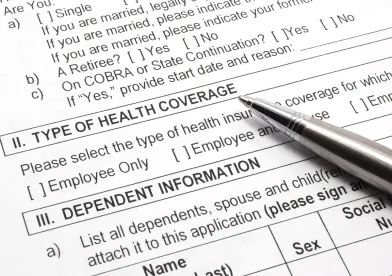Over the last few months, employers and plan administrators have concentrated on identifying qualifying individuals eligible for COBRA premium assistance under the American Rescue Plan Act of 2021 (“ARP”), sending out proper notices, and collecting election forms. Now that the dust has settled on the first round of election notices, employers and plans have turned their attention to another pressing topic: claiming the COBRA premium assistance tax credit.
Why is it Important to Apply for the Tax Credit?
ARP provides a 100% COBRA premium subsidy for qualifying individuals from April 1, 2021, through September 30, 2021. This subsidy is implemented by a tax credit mechanism. This means that the person to whom the COBRA premiums would otherwise be payable in the absence of the COBRA subsidy—generally, the employer or the plan and, sometimes, the insurer—must claim the tax credit to be reimbursed for the cost of providing “free” COBRA coverage to qualifying individuals. For details on determining who the “premium payee” is for purposes of the COBRA premium subsidy, please see our blog post overview.
What Taxes are Offset by the Credit?
The tax credit is intended to offset Medicare tax liability. If the amount of COBRA premium assistance provided to qualifying individuals exceeds the Medicare tax payable (for example, in the case of a multiemployer plan that does not have any Medicare tax liability), a refund of the excess amount can be requested.
How Is the Tax Credit Claimed?
The tax credit is generally claimed by reporting the COBRA premium assistance provided to qualifying individuals on the quarterly employment tax return (IRS Form 941). (Premium payees that do not normally file the IRS Form 941 because they do not have federal employment tax liability, such as some multiemployer plans, will have to do so to claim the tax credit.) There is a worksheet provided with the instructions to the IRS Form 941 that outlines how to calculate the two parts of the tax credit: (1) First, the non-refundable portion of the tax credit (the amount by which the COBRA premium assistance is offset by the Medicare tax liability); and (2) Second, the refundable portion of the tax credit (the excess, if any, of the COBRA premium assistance provided over the Medicare tax liability).
For more information about calculating the amount of the COBRA premium assistance that can be claimed as a tax credit, please see our blog post.
How Can the Tax Credit be Paid in Advance?
It is possible to claim the tax credit even before the IRS Form 941 filing deadline. There are two additional steps needed to get the credit faster. (1) First, an employer (or plan with federal employment tax liability, such as a multiemployer plan with employees or a multiemployer plan that makes benefit payments subject to withholding) may reduce the federal employment taxes it would otherwise be required to deposit up to the amount of the anticipated COBRA premium assistance tax credit. (2) Second, an advance of the anticipated tax credit after reducing available federal employment tax deposits may be claimed by filing an IRS Form 7200 with the IRS.
-
Practice Pointer: If a plan does not have any federal employment tax liabilities to reduce in step one (for example, in the case of a multiemployer plan that does not have employees and does not make any benefit payments subject to withholding), the plan can go straight to step two and file an IRS Form 7200 to request the anticipated tax credit.
-
Practice Pointer: IRS Form 7200 must be faxed to the IRS.
Even if the two steps above are used to claim the tax credit in advance, an IRS Form 941 is still required to complete the full claim for the tax credit. Any advance of the tax credit will need to be reconciled when IRS Form 941 is filed.
When Can the Tax Credit be Claimed?
Claiming the tax credit operates on a rolling deadline basis. There are two key dates, each described below.
-
Date of COBRA Election: The person to whom premiums are payable (e., the employer or the plan) becomes eligible to claim a tax credit for the COBRA premiums not paid by the qualifying individual so far on the date that it first receives the qualifying individual’s COBRA election. For example, if an employer receives a qualifying individual’s COBRA election on June 17, and the individual has not paid premiums starting April 1, the employer would become eligible on June 17 to claim the tax credit for the period of coverage from April 1 through June 30.
-
Beginning of Subsequent Periods of Coverage: At the beginning of each subsequent period of coverage, the person to whom premiums are payable becomes eligible to claim a tax credit for that coverage period (provided the individual remains eligible for COBRA premium assistance for that coverage period). Returning to the facts used above, the employer would become eligible on July 1 to claim the tax credit for coverage provided from July 1 through July 31.
When Can the Tax Credit be taken as an Advance?
If an advance of the tax credit is desired, different timing rules apply.
As a reminder, to claim the tax credit before filing an IRS Form 941, there are two steps: (1) Reduce federal employment tax deposits, and (2) Following the reduction of employment tax deposits to the extent available, file an IRS Form 7200 with the IRS to request an advance of the anticipated excess tax credit. The timing rules for eligibility to reduce federal employment tax deposits use the same schedule described above. However, if the employer or plan wants to file an IRS Form 7200 to request the anticipated excess tax credit following reduction of deposits, it must wait until the end of the payroll period in which it becomes eligible to claim the tax credit.
Returning to the second part of our example above, for coverage provided from July 1 through July 31, the employer would become eligible to reduce employment tax deposits on July 1—the first day of that coverage period. To file IRS Form 7200 to request an advance of the tax credit for coverage provided from July 1 through July 31, the employer would need to wait until July 16—after the end of the payroll period in which the employer first become eligible to claim the July credit (assuming the employer’s payroll period ran from July 1 through July 15).
Takeaway
This blog post provides a general overview on how to claim the COBRA premium assistance tax credit. Employers and plans should develop a course of action to ensure the timely recovery of any tax credits to which they are entitled. But don’t delay – for most employers and plans, the next Form 941 filing deadline is July 31, 2021, so the time to act is now.
Tanusha Yarlagadda, a Summer Associate, also contributed to this article.




 />i
/>i
